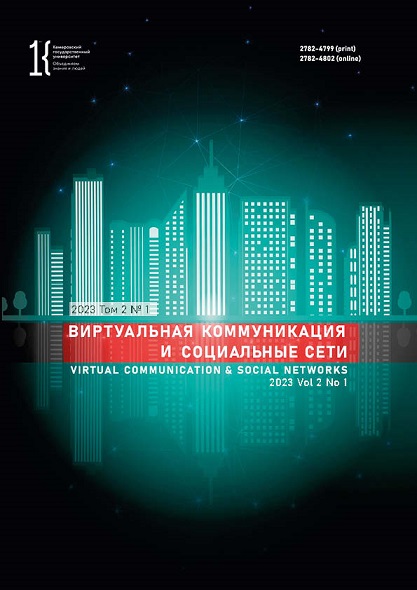Kemerovo, Kemerovo, Russian Federation
The digital mobilization of regional social and political interactions remains a relevant research topic. It provides obvious research innovations, new digital research algorithms, and non-trivial solutions, as well as an effective n-code measurement tool. Digital freedom means availability of network tools and services, where ordinary users can be actors of digital mobilization. In order to visualize an experimental scenario, the authors converted original data in the PolyAnalyst program to obtain thematic groups and an actor-network model for online communities of Kuzbass and the Tyumen Region. The generated dataset made it possible to consider common and different discussion topics, which were grouped by acute issues: crime, law, the military operation in Ukraine, infrastructure, etc. The study revealed some methods of user search and processing of chatbot requests. The digital tools demonstrated the regional features of the choice of online media, local resources, and topics. Online discussions give rise to new communication practices, i.e., the ability to receive, discuss, and shape relevant thematic agendas in real time, sometimes ahead of government officials and official media. This phenomenon can be explained by the availability of online community, hybrid communication technologies, repeated discussions, and alternative reliable sources.
social and political interaction, network communication, network communities, regional communities, digital mobilization, digitalization
1. Vakhshtain V. Imagining a city. Introduction into theory of conceptualization. Moscow: New Literary Observer, 2022, 576. (In Russ.)] https://www.elibrary.ru/htgzdq
2. Voronkova O. A. Network interiorization - the emergence of a new motivational matrix of social and political participation. Social and political researches, 2020, (1): 17-28. (In Russ.)] https://doi.org/10.20323/2658-428X-2020-1-6-17-28
3. Demenok S. L. Symbol and capital (Materialization of symbols). 2nd ed. St. Petersburg: Strata, 2016, 224. (In Russ.)]
4. Kosorukov A. A., Osipov V. S. The mechanisms of sociopolitical mobilization of youth on the example of Russian, Belarusian and Chinese telegram channels. Law and Politics, 2021, (9): 176-196. (In Russ.)] https://doi.org/10.7256/2454-0706.2021.9.36442
5. Kranzeeva E. A., Golovatsky E. V., Orlova A. V., Nyatina N. V., Burmakina A. L. Reactive social and political interactions in innovation processes in the Russian regions. Power and Administration in the East of Russia, 2021, (2): 86-102. (In Russ.)] https://doi.org/10.22394/1818-4049-2021-95-2-86-102
6. Kranzeeva E. A., Orlova A. V., Nyatina N. V., Grigorik N. N. Participation of the population of a region in the implementation of the national projects: retrospect and prospect. Russian Journal of Regional Studies, 28(3): 490-515. (In Russ.)] https://doi.org/10.15507/2413-1407.112.028.202003.490-515
7. Saburova L. A., Blagodatsky G. A., Stazhilov V. V., Vantrusov P. V. Factors of social mobilization in Internet communities. PNRPU Sociology and Economics Bulletin, 2021, (3): 156-170. (In Russ.)] https://doi.org/10.15593/2224-9354/2021.3.11
8. The life support system of the cities of Kuzbass: population resources and civil support, ed. Kranzeeva E. A. Kemerovo: KemSU, 2020, 305. (In Russ.)] https://elibrary.ru/qewmto
9. Social and political mobilization: a microsociological analysis, ed. Shpak L. L. 2nd ed., Kemerovo: KemSU, 2015, 369. (In Russ.)] https://elibrary.ru/wjosfl
10. Tarasov V. N., Kartushev N. A. Using publicly available data on users of the VKontakte social network to search for potential university applicants. Molodoy uchenyy, 2020, (21): 73-75. (In Russ.)] https://elibrary.ru/xincjr
11. Filatova O. G. Internet technologies in political mobilization of modern Russia. Political Expertise: POLITEX, 2014, (4): 57-67. (In Russ.)] https://elibrary.ru/veidxf
12. Oberschall A. Social conflict and social movements. Englewood Cliffs, N. J.: Prentice-Hall, 1973, 372.



















